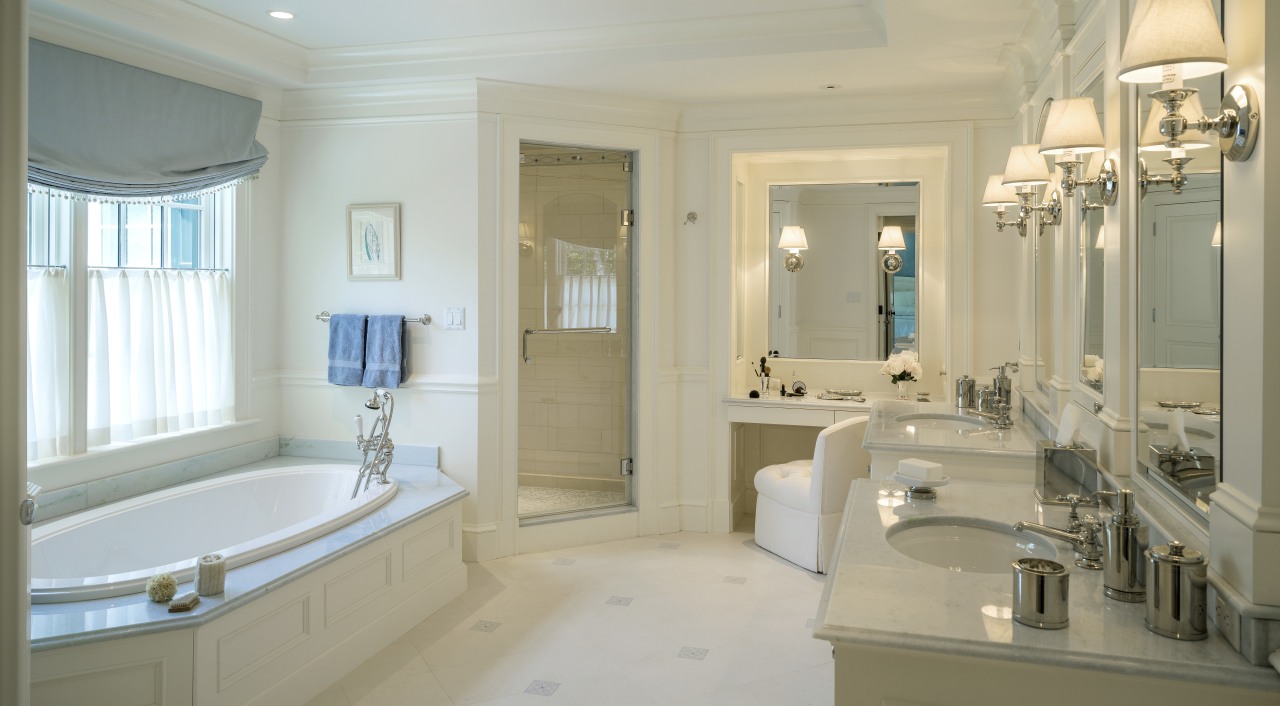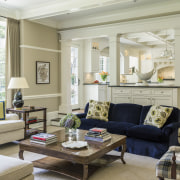New England Colonial house with fieldstone siding, shuttered windows, symmetrical facade
Traditional New England Colonial home by Jan Gleysteen features fieldstone facade, corner pilasters, colonnaded loggia, traditional interior

New England Colonial architecture is anenduring style that's just as appropriate for family living today as it was back in its heyday in the 1930s and '40s.
Architect Jan Gleysteen says there's a good reason for this such houses are not only imbued with traditional character and charm, but are also a symbol of the past. As such they conjure up feelings of warmth and familiarity.
"There is a scaling to these houses that ensures they seem to wrap protectively around the family," Gleysteen says. "This concept of scaling is readily evident in this property mature beech trees frame the house beautifully, and make it seem as though it has always been there."
The architect says the house replaces a 1980s modern house that was built on a 45° angle to the street.
"Most of the houses in the small town have a New England Colonial character and are built parallel to the street. The original house on this block had no curb appeal, so that was a key consideration in the planning of the new house. We placed it parallel to the street, on a slight rise, with a U-shaped driveway providing a double entry."
The traditional formality of the front elevation is also typical of the style. Gleysteen ensured the main volume has a strong symmetry to the extent that one of the two chimneys that anchor the sides of the house is purely for aesthetic purposes.
Other features of the New England Colonial style include the fieldstone siding, which is framed by prominent corner pilasters with recessed panels. The house also has black-forest green paneled shutters with exposed hardware, antique lanterns, and Georgian-style columns and dentil mouldings below the roof eaves.
"Unlike the rear, there are no dormer windows on the front elevation, which gives the house a simpler, cleaner look from the street," the architect says.

The recessed front entry opens to a hall with a relatively low 9ft 4in ceiling.
"An intimacy of scale was a specific request by the owners they didn't want an ostentatious double-height entry hall."
There is a direct line of sight from the entry through the house and out a French door to the entertaining terrace and woodlands at the rear. This helps to draw the eye to the view beyond.
The interior architecture also reflects the traditional influence. In the formal living room a mantel with a swag and medallion pattern replicates the mouldings in a Park Avenue, New York apartment designed in the '30s. And two solid painted beams, one on either side of the mantel projection, define the ceiling.
The traditional look is reinforced by furnishings, specified by interior designer Mollie Johnson. These retain the formality of the colonial style but reflect the warmth and welcome of a family home.
Bold geometric patterns and a textured grasscloth wallcovering soften the formality of the dining room, while the formal living room features light spring-green walls and neutral furnishings punctuated by warm red armchairs.
Most of the family living takes place in the kitchen, however.
"We always design the kitchen to be the piéce de resistance, the true hub of the home," says Gleysteen. "This room, as with the dining room and mud room, has a dropped soffit around the perimeter of the ceiling, which pops back up in the middle. The design helps to make these spaces more intimate."

The kitchen ceiling is coffered as well, with the beams centered above the island. This is on the main axis for the entire open-plan family living area.
"One end of this axis is anchored by the cooking center, which has an arched mantel. This is the symbolic hearth the heart of the home. The cooking center bookends one end of the entire space the opposite end is bookended by a fireplace."
Gleysteen says the island separates the circulation area from the main food preparation area. However, the space in front of the cooking center is part of a passage through to the breakfast room.
"We made this space a little wider, so the circulation would not interfere with cooking operations."
In keeping with the traditional styling, there are large 6in paneled pilasters on the corners of the island, with smaller versions on the perimeter cabinets. Curves are another classic feature helping to soften the linear form of the cabinets. These appear in the hood brackets and arch, and in the arched millwork that frames the window above the sink. The wood bar top on the island is also curved.
To maximize the spectacular green outlook at the rear of the house, the breakfast room resembles a glass pavilion. Johnson specified navy blue and spring green accents for both the breakfast room and the family room, which bring a touch of whimsy to the informal living areas.
Green furnishings reappear in a screened porch, where wicker furniture, a beadboard ceiling and exposed siding enhance the informal ambiance.
Beyond the house, the landscape is terraced to create two flat areas of lawn, with space for a kitchen garden that is netted to keep out rabbits and deer. There is also a 30ft by 40ft outdoor sports court.
Credit list
Architect
Landscape architect
Kitchen manufacturer
Roofing
Flooring
Paints and varnishes
Furniture
Kitchen cabinets
Backsplash
Bathroom accessories
Interior designer
Builder
Siding
Wallcoverings
Lighting
Drapes in living areas
Countertops
Bathroom flooring
Bathroom drapes
Story by: Colleen Hawkes
Home kitchen bathroom commercial design
Diving into nature
Classic looks, contemporary efficiency
Personality plus
Trends Vol 31 No 2
Whether a large sleek contemporary, a cottage with a warm traditional aesthetic, or a glass-walled apartment high above ...
Read More












